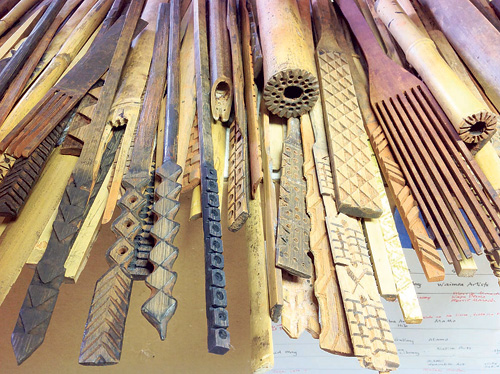Sitting on the second-floor lanai of her home in Makaha, kapa maker Dalani Tanahy pounds on a sheath of bark, surrounded by verdant views of the Waianae mountain range. It’s peaceful and quiet except for the meditative tap-tap-tap of the i‘e kuku (square-sided beater) on the wooden kua (anvil), which softens the inner bark of the wauke, or paper mulberry tree. Its final beating leaves an embossed pattern — a distinctive feature of Hawaiian kapa. Tanahy, 52, will finish the piece with a unique combination of colors from plant dyes and stylized designs.
It is one of two new pieces she created for the Maui Arts & Cultural Center, which will celebrate the Hawaiian art and craft of kapa making with events that start Saturday.
Tanahy and nearly two dozen other kapa makers from across the Hawaiian islands were invited to make an exhibit piece and a separate kapa pa‘u (skirt), malo (loincloth) or kihei (cloak) for a performance Saturday by renowned Halau o Kekuhi of Hilo. The troupe will present the premiere of "Hi‘iakaikano‘eau," a full-length hula drama celebrating the tradition of kapa.
A symposium on the history and Hawaiian values of kapa will follow on Sunday, accompanied by demonstrations.
KAPA CELEBRATION
Maui Arts & Cultural Center, Kahului mauiarts.org, 808-242-7469
“Hi‘iakaikano‘eau,” performance by Halau o Kekuhi
When: 7:30 p.m. Saturday
Where: Castle Theater
Cost: $12-$40
“The Kapa Maker’s Journey,” a symposium with Nalani Kanaka‘ole, Kekuhi Keali‘ikanaka‘oleohaililani, Marie McDonald, Roen Hufford, Dalani Tanahy and Kaliko Spenser, and demonstrations by Solomon Apio and the Maui Kapa Hui
Where: McCoy Studio Theater
When: 1 to 3 p.m. Sunday
Cost: $10
“Mohala Hou Ke Kapa: Kapa Blossoms Anew” exhibit
Where: Schaefer International Gallery
When: 10 a.m. to 5 p.m., Jan. 21 to March 9
Cost: Free
|
An exhibit featuring pieces by contemporary kapa artists, titled "Mohala Hou Ke Kapa: Kapa Blossoms Anew," along with artifacts from the Bailey House Museum in Wailuku, will be on display Jan. 21 through March 9 at the center’s Schaefer International Gallery.
"The design of this exhibit will reveal the history, tools and process of kapa making along with the work," said exhibit curator Neida Bangerter. "The dedication of time, plant knowledge, tool making and skill it takes to make kapa is tremendous and part of the reason we should value those who are keeping Hawaiian kapa alive."
For her performance piece — a malo for a male dancer — Tanahy was inspired by the sunrises and sunsets she’s seen while traveling by air on her many trips to teach kapa making around the world.
"There’s a particular combination of colors I like — deep blue, streaks of orange and yellow — and I always wanted to depict it on a kapa," she said.
She used those colors the length of the 1-foot-by-18-foot malo and incorporates a design depicting ha‘uke‘uke, or sea urchin, which is symbolic of the first creations to appear in the Kumulipo origin chant.
To make orange dye, she used achiote, or lipstick plant seeds; for blue, ‘uki ‘uki, or Hawaiian lily berries; and for yellow, ‘olena root. Darker shades were achieved by applying multiple layers of dye.
The overall effect is vibrant and striking. Tanahy took into consideration how the kapa would look on stage, with light and movement, and made sure it was strong yet supple so it can be wrapped snugly to stay on the dancer.
Her exhibit piece is "Na Wai Eha," inspired by the four rivers of Central Maui, including Waikapu, in the area where her mother grew up.
The water sources and flow diversions for agricultural uses have been at the center of a legal and cultural conflict on the Valley Isle. The title plays on the Hawaiian word "eha," which can mean both the number four and, when spelled with an okina, hurt or pain.
"It’s a statement piece depicting the pain, or ‘eha, of the water diversions and native water rights issues," she said.
Tanahy has nearly 20 years’ experience teaching and making the traditional fabric. Like many of the kapa makers scattered across the state, she tends her own grove of wauke and a collection of dye plants. She crafts her own tools, including the kapa beaters, anvil and stamps, out of hardwood and bamboo.
As part of the Maui celebration, renowned lei and kapa maker Marie McDonald of Hawaii island will offer a special retrospective of her works, some dating back to the 1970s and others new creations. She also will display her favorite tools.
One of her new works is a creative fusing of past and present that uses embroidery thread to join two pieces of kapa. McDonald’s daughter, Roen Hufford, also was invited to create kapa pieces for both the performance and exhibit.
The seeds for the Maui event grew from a memorable performance by the kapa-adorned dancers of Halau o Kekuhi who performed in the hoike showcase at the 2011 Merrie Monarch Festival in Hilo. (Watch their performance at vimeo.com/23066724 Opens in a new tab.)
The 25 kapa makers who collaborated on dressing the dancers got to sit in the front row and witness their handiwork come to life on stage during the halau’s powerful performance. Tanahy remembers the experience vividly.
"It was amazing to see all of our collective kapa work," she said.
"To see it move and come alive through the hula was breathtaking, and the dancers told us later that it was a nearly sacred experience for them to be wearing real kapa."
Two retreats followed that performance in which kapa makers had the opportunity to share and strengthen their art.
Tanahy continues to teach intensive kapa courses at her Makaha home and abroad.
"Kapa making was and continues to be a labor of love for those who rediscovered and breathed new life into it and teach it to those who want to learn," she said, as her rhythmic tapping continued.








